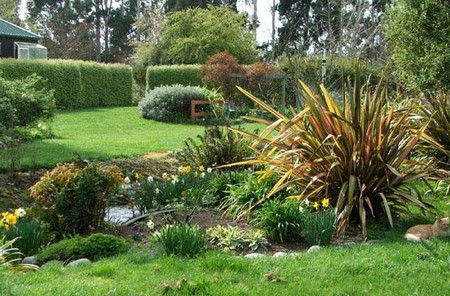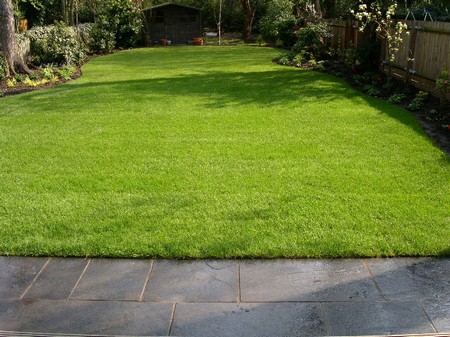A well kept lawn is an asset in any garden; grass makes a safe and economical ground cover. However, it does have limitations. It will not stand up to very heavy use; and it is not suitable for paths, patios and barbecue areas where it suffers badly, especially during wet or frosty weather. One of the basic rules of lawn care is never to walk over the lawn any more than absolutely necessary when it is over-wet, nor when it is frozen or covered with snow. And if you are using your wheelbarrow under adverse conditions like these, put down planks first. If you want a low-maintenance but visually-appealing lawn, you may consider using artificial grass.
For really heavy wear, opt for hardwearing materials like concrete, bricks or tarmac. Gravel or loose chippings are best avoided in close proximity to the lawn. Chippings are inevitably kicked onto the grass where they fly dangerously when mowing and damage mower blades into the bargain.

If a lawn is to be kept looking good, it must have a certain amount of care and attention. Although few householders will attempt to put down a complete lawn, most will be concerned at some time with lawn extensions and grassing over flower beds. The procedures are the same.
NEW LAWNS SEEDING OR TURFING?
Seeding is cheaper than turfing, but there is a time lag to consider. A lawn seeded down in early autumn won’t be ready for use until the following spring, and it will take little wear for 12 months thereafter. So, where there are children and pets to consider, turfing is the practical solution, as it is on heavy clay soils. Turf gives instant effect and is ready for use within a few weeks. But common sense is called for — only light wear for a while. Be mindful of the lifting involved in turfing and the actual weight of the turves. Turfing a lawn is heavy work by any standards and make it a two-person job if possible.
PREPARING THE SOIL
Preparatory work for seeding and turfing follow similar lines. In both instances a bed of well prepared topsoil of 10 cm (4 in) minimum depth is essential for success.
Start at least three months before the lawn is to be made. Having seen to drainage and levelling, dig over the plot. Remove stones and the roots of persistent weeds in the process, and don’t dig too deeply (you shouldn’t disturb the subsoil). Check that any part of the lawn butting up against the house is well below the damp proof course. Check that levels are slightly above existing paths, for ease of mowing. When preparing for turfing, take into account the fact that turves will be about 4 cm thick.
Allow the soil to settle for a few weeks, then fork a bucket of peat and half a bucket of sand per sq m (yd), into the top 15 cm (6 in) of soil. When dealing with heavy soils, double the amount of peat and sand.
Let the soil weather. Then start to level and firm, along the following lines. Rake over the area, removing all stones of any significant size and working the soil down to a fine crumb structure, while levelling out humps and hollows. Follow the raking by treading heel-to-toe fashion, to firm. Treading is better than using a roller, which tends to ride over air pockets (very often remedial treatment is needed later on to level out the hollows). Repeat the firming and raking several times, but only during dry weather when the soil is not wet.
Two weeks before seeding or turfing, rake in general fertilizer like Growmore, at the rate of a handful per sq m (yd). The site should now be ready. Note Banks steeper than one in three should not be grassed – this is in the interests of safe mowing. Steep banks are better terraced behind retaining walls, or planted up with ground cover. Seek professional advice.
TURFING
Spring and autumn are the best times to lay turf, but turves can be laid any time during the growing season, provided supplies are available, and provided the lawn can be nursed along afterwards, especially during periods of drought when watering becomes essential.
Mark out the area, using a line and pegs for straight “edges and a trickle of sand for curves. Always work from a plank to consblidate and level and avoid leaving foot indentations on the prepared soil.
Begin at a corner and lay turves in a straight line lengthwise. Stagger the rows like brickwork so that the joins do not align. Push each turf up firmly against its neighbour and tamp down gendy with the back of the spade. Never use force. Any unevenness should be corrected by adding or removing soil beneath the turves, so raising or lowering individual turves as need be. Check critical levels with straight edge and spirit level. As work proceeds, rest the plank on previously laid turves and work from this. On slopes, hold turves in place by driving in 12 mm diameter pegs of about 15 cm (6 in) in length, as soon as each turf is laid.
Finally, trickle potting compost into the gaps between the turves. Brush this well in and it will help to prevent drying out and shrinkage around the edges of the turves, while encouraging them to knit together quickly.
Edging
Cut around the edges of the newly turved lawn, using a spade or half moon edging iron. Use a plank as a guide for straight lines. The edges of a lawn should be cut down at right angles to the surface to form a shoulder. Anything less than perpendicular will create problems later on when routine trimming. Aim for a small dip of about 5 cm (2 in) where lawn meets flower bed.
Water lawns thoroughly after turfing and keep moist until established, otherwise drying out and shrinkage back at the edges is inevitable.
Note
Turves should not be left standing around after delivery. Aim to lay them within 24—48 hours or risk deterioration.
SEEDING
The best times to sow seed are mid-spring, after the soil has had a chance to warm up, and in early autumn while there is still some warmth in the soil. In cool or wet areas sowing times are therefore confined to relatively short periods, and turfing may be a better bet.
Choose a lawn seed to suit the garden. Go for a general purpose mixture for a hardwearing lawn. There is little point in sowing a fine lawn mixture and expecting it to stand up to children’s wear — it won’t. There are other considerations too. Is a shade mixture needed for example? Seed dressed with bird repellant is usually worth the extra cost. Allow 50 g of seed per sq m.
To help ensure an even distribution of seed, divide the lawn into strips of equal size, using pegs and string or a trickle of sand. After mixing the seed with twice its volume of dry sand (this makes sowing much easier), weigh it out. Then divide the allocation for each strip into two — sowing half evenly up and down the strip and the remainder across. Lightly rake the seed in and, to avoid the all too common mistake of raking too deeply, keep the handle of the rake near to the vertical. The alternative is to cover the seed by scattering over a mixture of equal parts potting compost and sand. In any event this is the best way to deal with heavy soils.
Protect the newly seeded lawn from birds by criss-crossing dark wool over the top. Tie the wool to pegs around the edges, to keep it raised some 7.5 cm (3 in) above the surface. Don’t use thread, which can cut and injure birds’ feet. Wool will tip the wings and scare the birds without causing injury. Keep the seed moist until growing away nicely.
Post-seeding care
Cutting
When spring sown lawns have made about 5 cm (2 in) of growth, handpick stones and then roll lightly. The rear roller of a mower serves the purpose well, keeping the cutter head clear of the seedling grasses. Leave for a few days then give the first trim. Tip off only the top 12 mm of grass. For a good job, tipping over with hand shears cannot be bettered; however, in practice most of us risk using the mower. The blades must be set high and they must be sharp but, even so, some of the grasses are bound to be uprooted.

A newly seeded lawn should not be used until it has been lightly rolled, and cut two or three times. You may also need lawn fertilizing services to achieve a lush lawn.
In the case of autumn sown lawns, tip them over if significant growth is made during the first five weeks after sowing. Otherwise leave well alone until spring. But during winter be ever watchful for disease and treat with fungicide at the first signs of trouble.
Don’t subject a newly seeded lawn to heavy wear for the first 12 months. And if those all too familiar cracks and crevices are to be avoided, aim to keep it well watered.
Edging
Don’t be too hasty to edge a newly seeded lawn. Let it firm up for about six months, allowing the grasses to bind the soil. Then edge as for turfing.